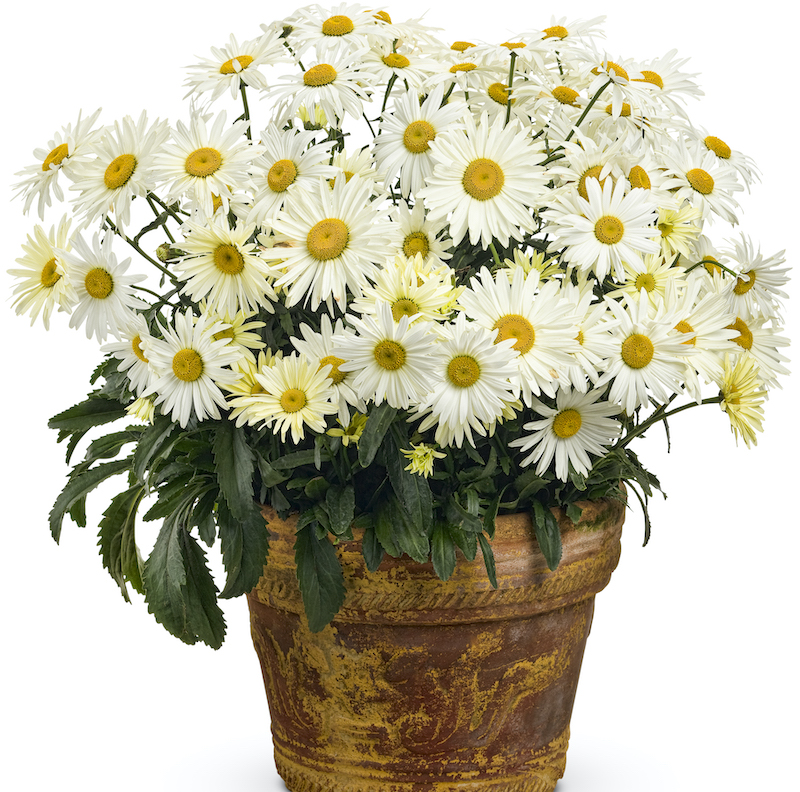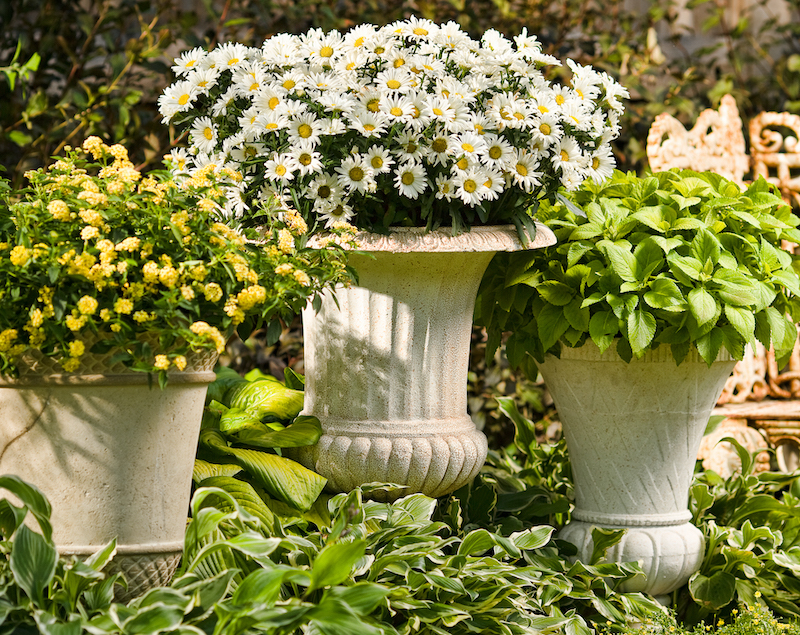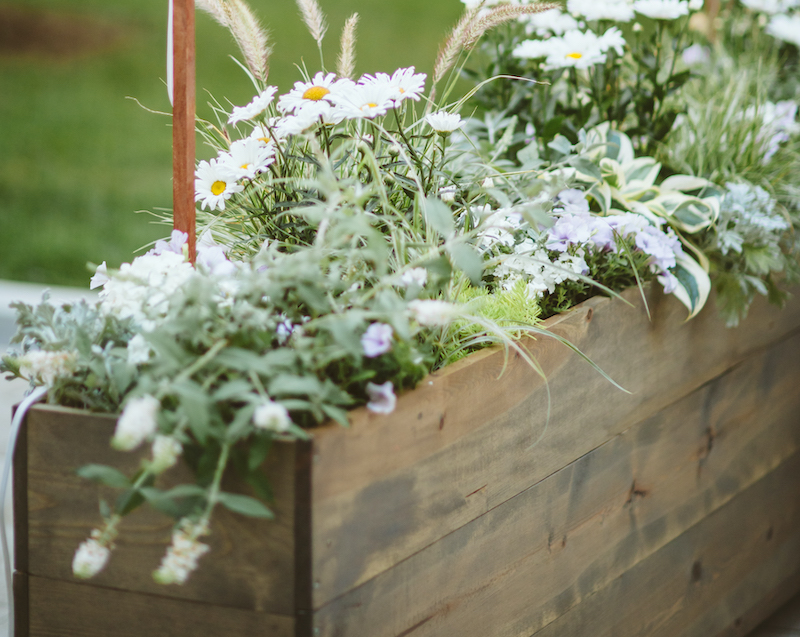Shasta Daisy (Leucanthemum x superbum) is a popular flowering plant known for its bright white petals and yellow center. These hardy plants were developed in Northern California and can be grown in various locations, including pots and planters. Shasta Daisies can thrive on a patio, balcony, garden, or even in an entryway or deck. They are a good choice for pots or planters because they are low maintenance and can withstand hot summer temperatures.
However, they require special care, such as regular watering and fertilizing, to ensure they remain healthy and produce beautiful flowers. Shasta Daisies are also suitable for large above-ground planters, as long as the planter soil has adequate drainage and the plants are not allowed to dry out.

Planting Shasta Daisy in Pots
When planting Shasta Daisy in pots, it is best to do so in the spring or early summer, when the weather is warm, and there is plenty of sunlight. Shasta Daisies prefer full sun or part sun locations, but they can also tolerate some shade. The size of the planter will depend on the size of the plant and the amount of space you have available. Choose a planter with adequate drainage holes to prevent the roots from becoming waterlogged. In terms of material, clay or plastic pots work well for Shasta Daisies. Be sure to choose a planter that is large enough to accommodate the roots of the plant and has enough space for the plant to grow.
Best Soil For Shasta Daisy in Pots
When planting Shasta Daisy in pots, choose a loose potting soil or mix to ensure drainage and aeration. Use a commercial potting soil, or you can make your own by mixing equal parts peat moss, compost, and perlite. Avoid using garden soil in pots, as it's too heavy.
It is also a good idea to mix in some compost, as it helps to enrich the soil and provide additional nutrients for the plants. Avoid adding rocks to the bottom of the pot, as this can impede drainage. Instead, use a light mulch to help retain moisture and suppress weeds. When adding mulch, leave a few inches of space around the base of the plant to prevent stem rot. Proper drainage is essential for Shasta Daisies, as they do not tolerate standing water and can quickly become waterlogged if the soil and container does not drain well.
Caring For Shasta Daisy in Planters
Caring for Shasta Daisy in planters requires regular watering and fertilizing to ensure the plants remain healthy and produce beautiful flowers. In addition to watering and fertilizing, it is also a good idea to deadhead the flowers regularly to encourage the plant to produce more blooms. Every year or two, transplant the daisies to a bigger pot and refresh the potting soil to prevent this vigorous plant from becoming root bound.

Watering Shasta Daisy in Pots
Proper watering is essential for keeping Shasta Daisy healthy and flourishing in pots. Water the plants deeply and regularly to ensure that the soil stays evenly moist but is not waterlogged. Generally, Shasta Daisies in pots should be watered once or twice a week, depending on the weather and soil conditions. In hot, dry weather, the plants may need water every few days to prevent the soil from drying out. Conversely, gardeners may water the plants less regularly during heavy rain or high humidity periods.
To determine when to water, stick your finger about an inch into the soil. It is time to water if the soil feels dry at that depth. If the soil is still moist, wait a few more days before watering again. Avoid getting the plant's leaves wet, as this can promote fungal growth.
Using rainwater, rather than tap water, is also beneficial for Shasta Daisies in pots. Rainwater is generally softer and has fewer minerals than tap water, which can build up in the soil over time and lead to nutrient deficiencies.
Fertilizing Shasta Daisy in Pots
Fertilizing Shasta Daisy plants in pots is important to encourage healthy growth and abundant blooms. Shasta Daisies are relatively low-maintenance plants and do not require frequent fertilization, but a formula for blooming plants can help to provide the nutrients they need to thrive. Choose an organic formula with a higher ratio of phosphorus and potassium to nitrogen, to encourage blooming and root growth.
Shasta Daisies in pots should be fertilized monthly during the growing season, using a water-soluble fertilizer. Apply the feed according to the manufacturer's instructions and avoid over-fertilizing, as this can burn the plant and lead to floppy, weak growth.
It is also important to remember that potted plants may require more frequent fertilization than in-ground plants, as they may deplete the nutrients in the soil more quickly. This is especially true for container plants grown in small pots or with a high nutrient requirement, such as Shasta Daisies.

Winter Care For Shasta Daisy in Pots
Shasta Daisies in pots may require extra protection during the winter months in colder climates to ensure their survival. Choose a frost-resistant pot, as extreme cold can cause terracotta or ceramic pots to crack. If you are concerned about the pot cracking, you can wrap the pot in bubble wrap or burlap to provide additional insulation.
Winterizing Shasta Daisy plants in pots involves simple steps to help the plants survive the cold weather. First, stop watering during the winter, as the plants will be dormant and will not need as much moisture. Only water if your area receives minimal precipitation in the winter, and the soil is cracking.
Second, mulch the top of the soil with a layer of straw, leaves, or compost to help insulate the roots and protect them from extreme temperatures.
Finally, consider bringing the plants indoors if you live in an area outside the growing range of Shasta Daisy. Pots can be moved to an unheated garage or basement to overwinter. They will need water about once a month to make sure the soil doesn't completely dry out.
Growing Shasta Daisy Indoors
Shasta Daisies go dormant during the winter and do not make good houseplants. They benefit from rest during the winter months, when the days are shorter, and the plants do not produce as many flowers. For potted plants brought indoors, place them in a cool area, such as a basement or garage. Reduce watering and fertilization, and allow the plants to rest.
 |
Author Chris Link - Published 2-6-2023 |
